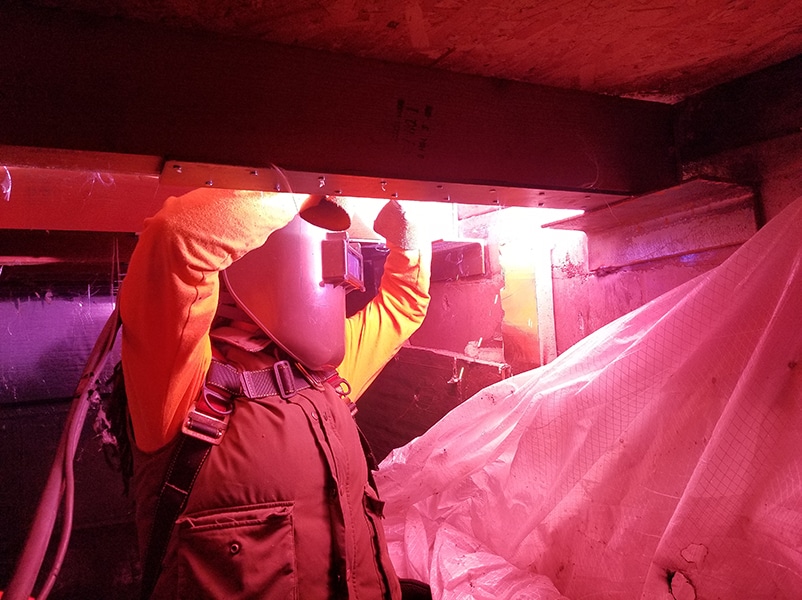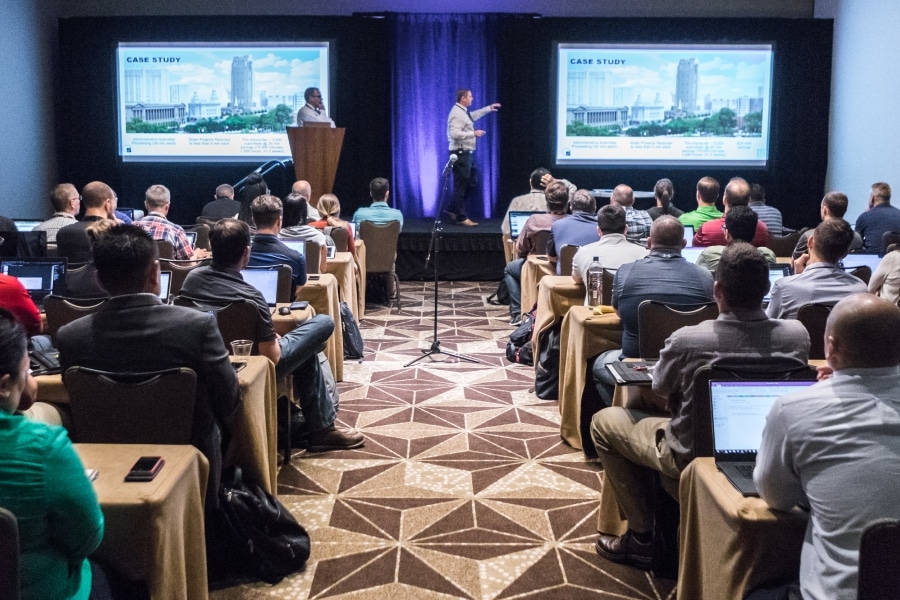Video produced by Justin Gaar
“Hey, ladies and gents—it’s ya girl,” cracks Lashanna Lintamo while holding a slightly unsteady smartphone camera as a noisy construction jobsite bustles in the background.
Wearing dark sunglasses, a white hard hat, layered sweatshirts and a safety vest—all beneath a thick layer of tightly wrapped dreadlocks resting around her shoulders—Lintamo is using her short break as a welder to answer a question for her YouTube audience that has come to define much of her life:
Should women get into welding?
“You’re not only going to be welding out here, ladies,” Lintamo says in the video, popping a bright, energetic smile. “You’re gonna put up beams, OK? You’re gonna drop in tubing. You’re gonna drop in your I-beams. You’re going to be doing all types of things.”
“Don’t just go out there and focus on being a good welder,” Lintamo adds, wrapping up the one –minute-and-22-second video. “You gotta be out there and get ready to be as tough as the guys, OK?”
In another video on her channel, “The Fashion Welder,” Lintamo talks into the camera as her grandfather, in his mid-90s, is hunched over outside building with some wood. “Another day out here with Grandpa,” Lintamo tells the audience. “This is where I get my craft-and-trade skills from.”
Lintamo’s YouTube channel has a modest reach by most conventional metrics. Her roughly 400 subscribers may be tiny in the grand scheme of the internet, but her content on welding, fashion, culture, cooking and spirituality is indubitably mighty.
As proof, consider the comments her videos receive.
“I start welding school soon … I’M SO NERVOUS. YOU ROCK,” wrote one commenter. “We need more of you Chica,” wrote another, followed by a strong arm and heart emoji.
Lintamo is an uncommon sight in construction: a Black, female welder and ironworker. She says her social media presence, which includes Facebook and Instagram, aims to inspire other women to consider the profession. It’s also designed to showcase and promote her larger endeavors and ambitions.
These include media projects with other Black welders; an up-and-coming clothing line; a media platform for Black creatives; an at-home childcare business; and establishing an apprenticeship program in Ethiopia.
“It’s a lot, but it keeps me busy,” said Lintamo, who is also married with a 4-year-old son. “I’m an entrepreneur. I’m a freelancer. That’s what I do.”
A family affair
Welding isn’t just a career for Lintamo—it’s in her blood.
Her distant great-grandfather was a blacksmith welder in the slave trade. Her great-grandmother built and welded on ships on the homefront during World War II.
“I disassembled and welded on the same ships on Mare Island in Vallejo, California,” Lintamo said. “She built them, and I took them down.”
Lintamo’s grandfather is a self-taught welder as well.
Lintamo said she was first exposed to the trade at about age 3, when she would hang around with her grandfather as he welded. Her earliest memory: one time while her grandfather worked, a small fire broke out.
“I went and grabbed the water hose and put it out,” Lintamo said. “I was just a little girl playing in the water. But when he lifted up his hood, it just really tickled him to death. He calls me Weasel. ‘Weasel, what are you doing?’ he said. I said, ‘Grandpa, I’m the fire chief.’ And so he always tells that story.”
Upon graduating from high school in the greater Sacramento area, working in the construction trades for Lintamo went from being a passive childhood interest to a serious career path. “My grandfather, my uncle and my dad—they all pulled me together and were like, ‘Hey, the economy is changing. … You need a trade.’”
Lintamo enrolled at a pre-apprenticeship program, Cypress Mandela Training Center Inc., in nearby Oakland, graduating in six months. “They took us through vigorous activities, workouts, trainings,” Lintamo said. “They set us up with our first credentials.”
Like most looking to break into construction, Lintamo finished her pre-apprenticeship in search of a local union. She managed to latch on with Local 342 Plumbers & Pipefitters in Concord, California, being one of a small number of people able to pass its rigorous qualifications exam and interview process.
Her first project was on the Dublin BART mass transit station, busting cast iron for the project’s foreman. “Oh my goodness—it was so heavy; it was so hot,” Lintamo said. “It was a hot mess, but that’s when I got a chance to first see some real industrial thrill welding going on.”

The experience inspired Lintamo to get serious about the trade. Her next gig, at a local Chevron refinery, gave Lintamo the opportunity to observe seasoned welders in action. “They took me under their wing and I was able to get under the hood,” Lintamo said. “I spent a lot of hours watching the old timers during the turnarounds at the refinery. That’s when I started really getting into it and studying it.”
Her studies led her to take a one-semester course at Yuba College, about 43 miles north of Sacramento. After passing, Lintamo ventured out into the field as a welder, ultimately deciding to remain a freelancer instead of joining a union. “I didn’t want to be limited,” she said, “and I’m just an adventurous person.”
There was another reason Lintamo didn’t want to commit to a union.
As typically the only Black female on most jobsites, Lintamo said she was often on the receiving end of harassment. “Being out in the field at times you just get sick of fighting and being criticized and being put down,” Lintamo said. “You get tired of crying because you’re not equal in others’ eyes, so I went off as a freelance welder.”
“Being a woman and being a Black woman in this industry is a knot,” Lintamo continued. “There are very few, so you do have to work a little bit harder, especially when we’re competing against some heavy structured guys out there, or people who already know someone who’s inside, making inside connections.”
Breaking down barriers
Lintamo made her own connections in a way that would make most others her age uncomfortable.
“Someone asked me just the other day: ‘How do you get these jobs? How do you sell yourself as a welder and get them to trust you?’” Lintamo said. “I just told her, ‘Girl, you’ve got to walk up in there and you have to take it.’”
So that’s what she’s done.
“I would find out who the boss is—who’s the person wearing the big boots? Who makes the decisions?” Lintamo said.
“I’ve gone in the office and I ask for that person. I do that because over the phone you get shut down. They won’t even give you a chance. In person, I get the chance to break that wall down. I get a chance to make eye contact when you walk across the corner, look you in your eyes, reach out my hand for that firm handshake. I Introduce myself, because when you have a face and a name together, they’re not going to forget you.”
Lintamo’s pitch is simple.
“When is your next job call? I have my stuff in the car; I’m ready to go. My gas is full; let’s do this, because I’m about to level up your business.”
This approach has helped Lintamo secure welding gigs working on everything from luxury homes to hotels and churches. Still, being the only Black female on most jobs remains a struggle.
“That’s the battle I face in my journey as a welder,” she said. “That’s why I became freelance, because I didn’t have a team. I found myself by myself all the time, just getting pushed aside, getting stepped on, getting used.”
“The payments, unequal pay and just unequal justice to sexism, the harassment, the racism—that takes a toll on you,” Lintamo added. “I’ve dealt with it my whole life.”
Such injustices haven’t stopped Lintamo from becoming a coveted welder. She said that her track record and persistent, tireless networking skills have allowed her to earn jobs she otherwise wouldn’t be considered for. She also said she is grateful to have connected with so many mentors along the way who have helped her advance in her career.
Bigger aspirations
Lintamo is unwavering in her belief that more women—Black women, in particular—should follow her lead and join the trades. “The secret is we’re the ones that make money,” Lintamo said. “People are making $75/hour or $65/hour or $100/hour, and that’s not spoken; that’s not taught in schools.”
Learning a skilled trade isn’t just a professional skill, either. It’s a skill that has application in everyday life. “It’s essential,” Lintamo said. “I encourage everybody to pick up a trade so that you know how to have something essential in your life.”
Welding, to Lintamo, has certainly been more than just a trade—or even a career. It’s been a lifestyle, a pathway for her to pursue deeper, more meaningful aspirations. Lintamo said welding has allowed her to realize that she can build, and do, anything.
“When you go back and look at your work, that’s the greatest feeling,” she said. “Sometimes you go through hell putting that stuff in. Sometimes it can be hard, very challenging, physically and mentally. But it’s so rewarding to look at something you built and say, ‘You did that. You did.’”











